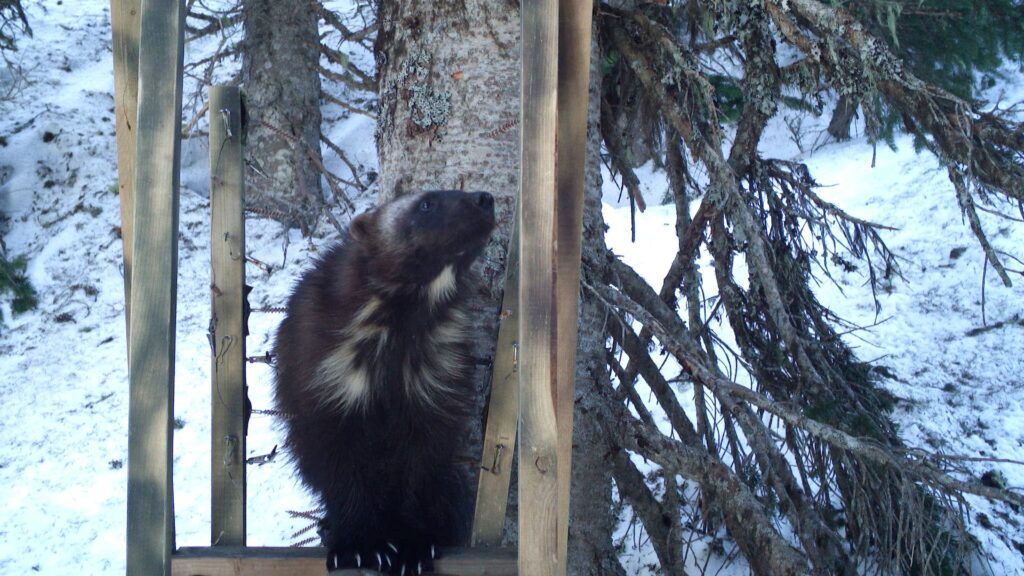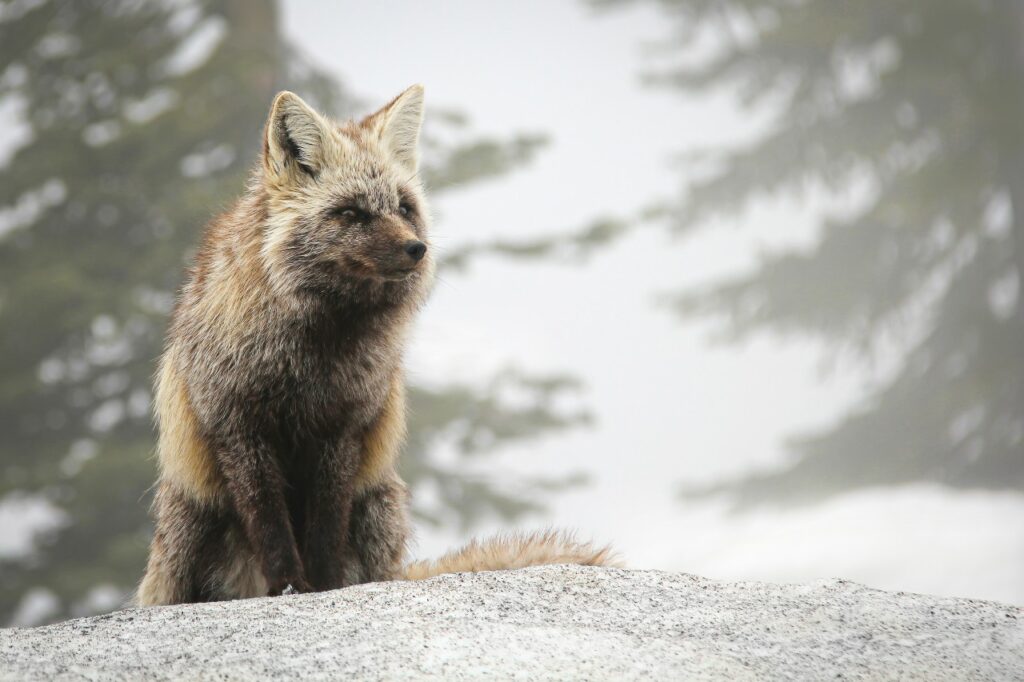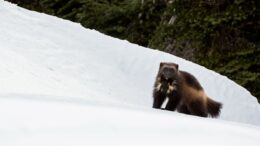When the Yakama Nation detected a wolverine on Washington’s Mt. Adams in 2005, outside the animal’s known distribution, Jocelyn Akins wanted to learn more. Was it part of a population that hadn’t been previously known or a lone animal seeking new territory?
To answer those questions, Akins, who had previously studied wolverines and grizzly bears in the Rocky Mountains, launched the Cascades Carnivore Project in 2008. Studying these elusive and rare mountain carnivores is no easy feat. After setting up remote camera traps with the help of friends and other volunteers, it was 15 months before they got their first photograph of a wolverine. And it wasn’t until 2018 when field researchers working with Akins documented the first female wolverine in 75 years in Washington’s South Cascade Mountains.
Over the course of months skiing and snow-shoeing into remote alpine areas, Akins also became fascinated with another rare and elusive mountain dweller: Cascade red foxes, a subspecies found only in Washington that sits perilously close to extinction. With very little known about them, she embarked on a Ph.D. program to use genetics to understand the conservation status of these foxes and figure out ways to reconnect their populations across the landscape.
The Cascade Carnivore Project now helps lead research efforts into three rare, elusive mountain predators in the region: Cascade red foxes, wolverines and Canada lynx.
The Revelator spoke with Akins about the challenges of studying these animals, why they’re important to the ecosystem and what’s needed to help them recover.

What are you finding out about these three species?
Rare carnivores, especially ones that live at high elevation, are hard to collect data on. They naturally occur at low densities, and then they’ve had many threats from habitat loss to over-trapping to loss of connectivity that’s causing numbers to go down even further.
Much of getting a handle on the conservation needs of high-elevation carnivores is first getting baseline data. We know that these three species are extremely low in abundance. All of them only occur in a portion of their historical distribution — their range is really contracted.
Canada lynx are probably doing the worst of all of those three species. There are very few left in Washington. They occur almost exclusively in western Washington, east of the Cascade crest, in the Okanagan area.
How do you go about studying them when they’re hard to find?
You’ve got to tromp out there into far-away places just to get to where they live, but that’s what attracted me to this research. I just love to figure out how to do this.
We use non-invasive methods to collect information on the species without ever seeing them.
We hike along trails up high in the mountains and collect carnivore scats. We do this systematically across vast swaths of the Cascade range with field crews and community science volunteers. That allows us to identify different individuals within a species and then look at the health of the population.
The other thing we do is we set camera stations designed specifically for wolverines.

They’re set up in a way that the photographs show the ventral side of the animal — their throat and chest — because each wolverine has a unique white pattern in that area that we call a chest blaze. We can identify each wolverine just based on photos, and then we can track them as they move from one of our stations to another and better understand which portion of the landscape they occupy.
They also leave hair samples that we can send to the lab and have the DNA extracted. That allows us to compare individuals and understand if the genetic diversity of a population is low or if an individual has the signature of a Canadian wolverine or a wolverine from Idaho. We can understand this recolonization that the wolverines are doing on their own. Where did they come from to return to Washington?
[By around the 1930s] they were all wiped out from the western United States by over-trapping. There had also been this systematic targeting of carnivores that was focused on other species — primarily wolves, coyotes and bears — but it really had an impact on wolverines because they’re scavengers and they were eating the poisoned bait.
Eventually wolverines returned to Washington on their own from British Columbia. And there’s been a wolverine nicknamed Stormy, living in the Wallowa Mountains in [eastern] Oregon, that came from Idaho.
This year in May a wolverine was photographed on the south bank of the Columbia River in the suburbs of Portland. It was just bonkers. We don’t know if that wolverine swam across the Columbia River and came perhaps from our study area in Washington. We’re waiting for someone to get a better photo.
It was in Portland and then beelined into the Cascades of Oregon.
Coincidentally, a couple weeks later, a wolverine showed up in central California, but it’s probably not the same one. That would be a bit too far.
There was one wolverine in California in 2008 that had the signature of an Idaho wolverine. So there’s a couple avenues that they can use to repopulate the lower 48 in the Western states. But it’s a really slow process and full of tons of risk.
What are you learning about how climate change will affect the three species you’re studying?
All three species are snow-adapted. Lynx have these enormous feet. Wolverines do as well. Cascade red foxes occur at high elevation year-round. It doesn’t come down in the winter like cougars and bears do following elk and deer. These three carnivores rely upon snow. They are adapted to snow. They’re good at capturing prey on snow throughout the winter.
The wolverine is particularly interesting because wolverines give birth in the heart of winter from about January to March high up in the mountains at treeline. The moms dig through the snowpack right down to the ground. In the Cascades, that’s 10 or 12 feet of snow. This snow den protects the wolverine kits from predation and cold.
It’s very important for wolverines to have snow. Globally more than 90% of wolverine habitat is where snow persists into the late spring because the females need the snow to have their dens, and then they need the kits to stay in those dens as the first spring is happening. In February, March and April, the little wolverines are in the dens. And if the snow were to melt too fast at that time of year and disappear, then those kits would be really vulnerable to predation.
The other thing that’s super cool is that females provision their kits on their own. She has to roam her territory — a much smaller area of it, because she can’t leave her kits for too long because they won’t survive. So she needs to have food sources that are close by in the middle of winter at high elevation, where there’s snow everywhere, and there’s just not that much food because all the other species have moved down in elevation or are hibernating. There are just a few species active in the winter.
One thing that she does as a scavenger is if she finds a carcass in, say, the early winter, she’ll shove it down a tree well near her den or her den-to-be. And then she can find that food later, and she can bring it to her kits, or she can eat it herself because she can’t travel too far from her den. The tree wells act like refrigerators. They keep the food cold and safe. That’s another important reason why wolverines need snow.
We’re doing a study right now called DNA metabarcoding, where we extract every fragment of DNA that’s in the wolverine scat, and then we sequence it. We can see all these different prey that the wolverines are eating, and we can learn what are the important species. We’re starting to accumulate a list of exactly what they eat in Washington — it’s things like snowshoe hares, hoary marmots, songbirds and some ground squirrels. Mostly small mammals up to mountain goat carcasses.
What are the challenges to trying to conserve these carnivores? Do you find public opposition even though these animals rarely interact with people?
Wolverines, foxes and lynx aren’t eating people’s livestock. They’re up high in the mountains, and so they’re not preying on people’s pets. Still, I’m surprised when people are opposed to rare carnivore conservation.

I think there’s so much to be done to educate people about the role [of these animals] in the ecosystem. As predators they keep prey populations in check. They’re out there preying on the weak and the injured first. Those are the easier animals to kill. So they keep disease in check. They keep prey populations healthy, and as a result, prey populations don’t overpopulate the landscape and they don’t over-browse it or negatively impact native plant species.
One of the big challenges is that a lot of people just don’t even know that these species even exist. Certainly people rarely see them. When I started the Cascades Carnivore Project, people didn’t even know what a Cascade red fox was. And X-Men hasn’t really helped. Everyone just thinks that wolverines are superheroes.
I think there’s quite a bit of support for their conservation, but there’s still a long way to go.
What do they need to recover? Is it better connectivity from things like safe highway overpasses or do they need more large areas of land to be protected?
Probably both. A lot of their habitat is within protected public lands. Some are in wilderness areas. And some do occur outside of protected areas. But they also need to cross unprotected lands to disperse and set up new home ranges.
Major highways are quite a large source of mortality for those three species, especially for wolverines. We’ve lost several wolverines in the last couple years from road kills. When you think that there’s something like 35 to 45, maybe 50 wolverines in Washington, and you lose one or two a year — especially in the south Cascades where there’s less than 10 — it doesn’t bode well for the population sustaining itself.
We’re just starting a genetic study of Canada lynx, so we don’t have answers there, but for the Cascade red fox, they’re somewhat inbred, and their levels of genetic diversity that we can test through sampling their DNA are low. There are barriers across their distribution, particularly Interstate 90. Connectivity is a problem for all three of those species.
There’s a legacy of population decline from those things I mentioned, like trapping and predator control programs that were targeting other species. In order for these high-elevation carnivores to recover, their populations need to grow, and then they need to be able to move across the landscape. Right now that’s hard because there’s lots of human disturbance in between places where they might like to set up a home range.
Previously in The Revelator:
Fisher Rewilding: How Washington State Is Restoring a Native Carnivore
![]()


